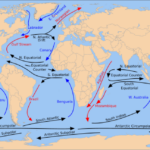What Are Ocean Currents?
Ocean currents are continuous, directed movements of ocean water caused by factors such as wind patterns, temperature differences, salinity gradients, and the Earth’s rotation.
Ocean currents play a crucial role in regulating the Earth’s climate by redistributing heat around the planet.
Understanding ocean currents helps scientists and conservationists protect marine environments and predict climate patterns.
Types Of Ocean Currents
- Surface Currents: They are driven by wind patterns and mainly affect the top layer of the ocean. These currents flow in large circular patterns called gyres. An example is the Gulf Stream.
- Deep Ocean Currents: These currents, called thermohaline circulation, are caused by changes in water density, which depend on the water’s temperature and saltiness. An example is the global conveyor belt.
- Upwelling: Upward movement of deep, nutrient-rich water to the ocean surface, typically along coastlines, driven by wind patterns.
- Downwelling: The downward movement of surface water, which can carry oxygen to deeper ocean layers.
Impact On Marine Life
Ocean currents have a significant impact on marine life in several ways:
Nutrient Distribution: Ocean currents transport nutrients from deep waters to the surface through upwelling, supporting phytoplankton growth.
Migration Pathways: Many marine species, such as fish, sea turtles, and whales, use ocean currents as migratory routes to cover vast distances.
Temperature Regulation: Ocean currents are crucial in regulating sea temperatures, creating habitats suitable for various marine species.
If ocean currents were to stop, it could disrupt marine ecosystems, affect climate patterns, and impact global weather systems.
Fun Facts
Here are some interesting facts about ocean currents:
- The Antarctic Circumpolar Current, also known as the West Wind Drift, is Earth’s most powerful ocean current.
- The El Niño and La Niña phenomena are related to changes in ocean currents in the Pacific Ocean.
- The Gulf Stream, one of the most well-known ocean currents, moves water up to 5.6 miles per hour, faster than most other currents.
- The Antarctic Bottom Water current flows at the ocean’s deepest levels, carrying very cold, dense water from Antarctica across the ocean floor.
Review
Let’s quickly recap what we learned about ocean currents:
- What process brings nutrient-rich water to the surface? Upwelling
- What type of ocean current occurs due to differences in water density? Thermohaline
- What is the main factor that influences surface currents? Wind Patterns
- What are the large circular patterns in which surface currents flow? Gyres


Recent Comments